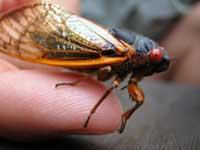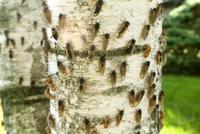Jugs and primary numbers

Periodic chicharros are a species typical of North America. There are 6 species of periodic chicharro: three have a life cycle of 17 years and three of 13 years. They have longer life cycles between insects.
The life of the periodic jugs begins in the subsoil, where chicharro nymphs absorb food from the roots of the trees. After 17 years of waiting, millions of chicharros leave the underground. After a few weeks, each female lays between 400 and 600 eggs on the leaves and branches of the trees and then dies. The chichas leave the eggs in 6-7 weeks and fall to the ground just outside. Immediately they get underground and there they spend the next 17 years.
In view of this, zoologists were concerned about why chicharros spend so many years under the ground. And what is more mysterious, why is the number of years of these cycles the first?
Primary Numbers Primary Numbers
The first numbers are numbers that can only be divided by oneself or by one: 1, 3, 5, 7, 11, 13 and 17, for example. It seems that when the number of years of life cycle is the number one gets a certain advantage to survive.

According to a theory, periodic chicharros have developed this system to avoid some parasite. Suppose the parasite has a two-year life cycle. If the life cycle of the jar is multiple of two, the chicharros and parasites will coincide regularly.
Thus, if the chicharro wants to avoid the parasite, the best strategy is to develop a long life cycle. In addition to a long life cycle, when the number is the first, the probability of meeting the parasite decreases. For example, if the life cycle of the jar is 17 years and that of the parasite is 2 years, they will be found every 34 years; and if the life cycle of the parasite is 16 years, every 272 years.
Possibilities of the parasite
What can the parasite do to meet the chichas? The first option would be to appear annually. In this way, every 17 years it would be adapted safely together with the chichas. However, in this situation, the parasite may not reproduce for 16 consecutive years, since in the first 16 years of appearance there will be no parasitic chichas.

The second option would be to develop the same long life cycle as txitxarra. To do this, they would have an increasingly long life cycle from one generation to another, arriving at some point to have a cycle of 16 years. Thus, at an evolutionary time, in 272 years they would not match the chichas.
This second option could explain why the parasite of chichas never been found. In the struggle for the encounter with the pitcher, it is possible that the parasite has prolonged its life cycle to exceed 16 years. Thus, the parasite and the jar would not be found in 272 years, which has led the parasite to destruction.
The result is a jar with a life cycle of 17 years, although this cycle is no longer necessary, since the parasite no longer exists.
Published in 7k
Buletina
Bidali zure helbide elektronikoa eta jaso asteroko buletina zure sarrera-ontzian











